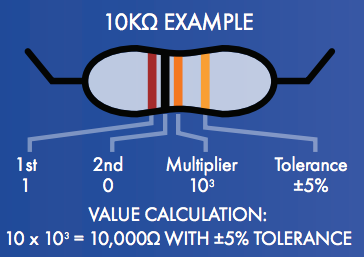Resistors are one of the most used components in electronics and almost every circuit you make will use one in some form. They're really useful components but usually only when you use the correct value. They're not like other components that have their value/name written in text on them. Resistors have their values shown on them using a number of coloured bands.
Colours/Bands
Most resistors will have 4 to 6 coloured bands on them, the bands are used to calculate the resistors value, tolerance and reliability.
The first three bands are used to create a three-digit number, the fourth band is a multiplier which is applied to the number.
If the first three bands were Brown, Black and Black then the number would be 100. If the fourth band was Orange then the number would be multiplied by 103, 100 x 103 = 100,000Ω
The fifth and possibly sixth bands are a tolerance and reliability percentage.
| Colour | 1st | 2st | 3rd | MULTIPLIER | TOLERANCE | RELIABILITY |
| Black | 0 | 0 | 1 | |||
| Brown | 1 | 1 | 1 | 10 | ±1% | 1% |
| Red | 2 | 2 | 2 | 102 | ±2% | 0.1% |
| Orange | 3 | 3 | 3 | 103 | ±3% | 0.01% |
| Yellow | 4 | 4 | 4 | 104 | ±4% | 0.001% |
| Green | 5 | 5 | 5 | 105 | ±0.5% | |
| Blue | 6 | 6 | 6 | 106 | ±0.25% | |
| Violet | 7 | 7 | 7 | 107 | ||
| Grey | 8 | 8 | 8 | 108 | ||
| White | 9 | 9 | 9 | 109 | ||
| Gold | ±5% | |||||
| Silver | ±10% | |||||
| None | ±20% |
Below is an example of a 10KΩ resistor which is taken from our education poster designed as a classroom resource.


